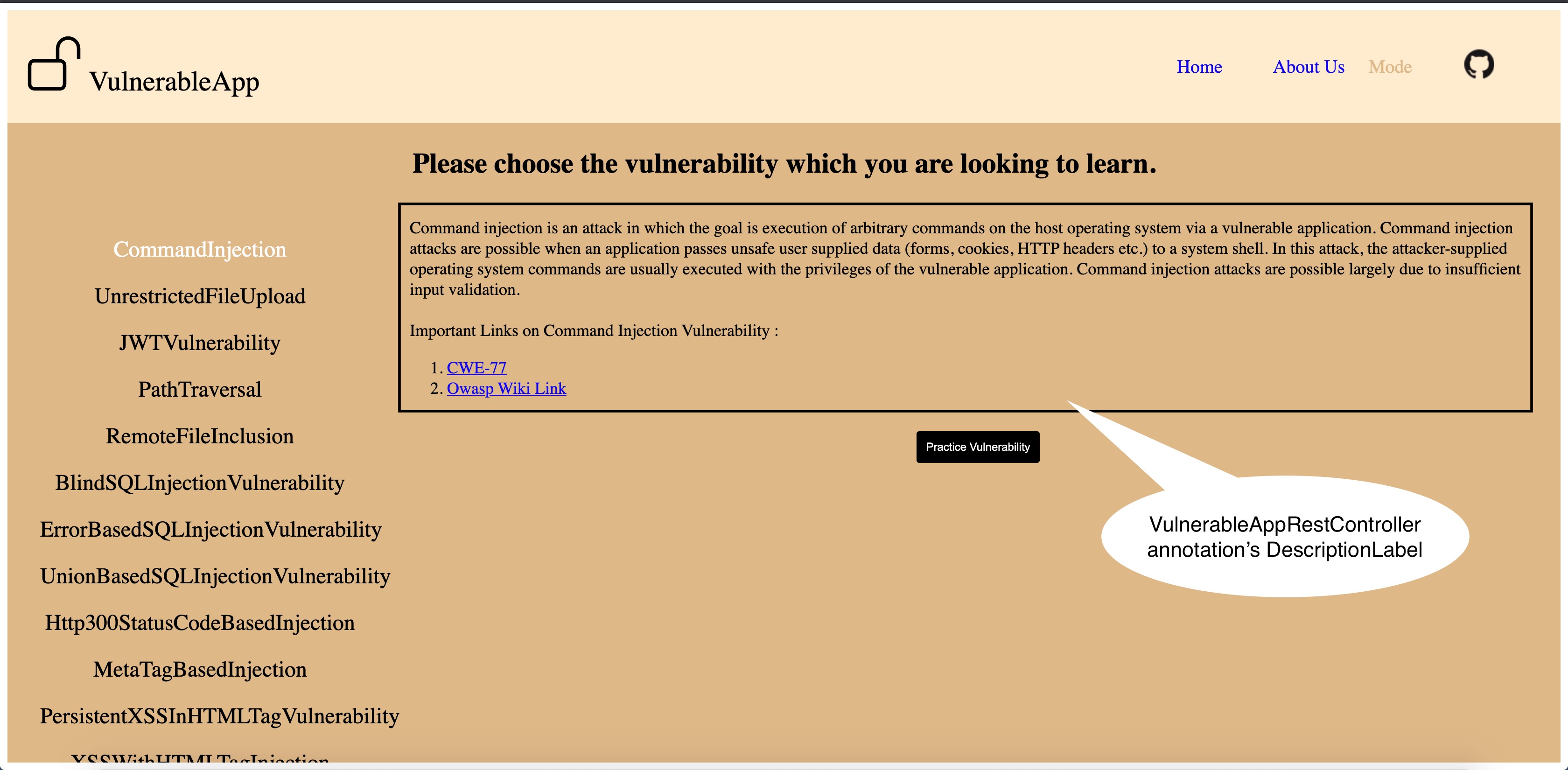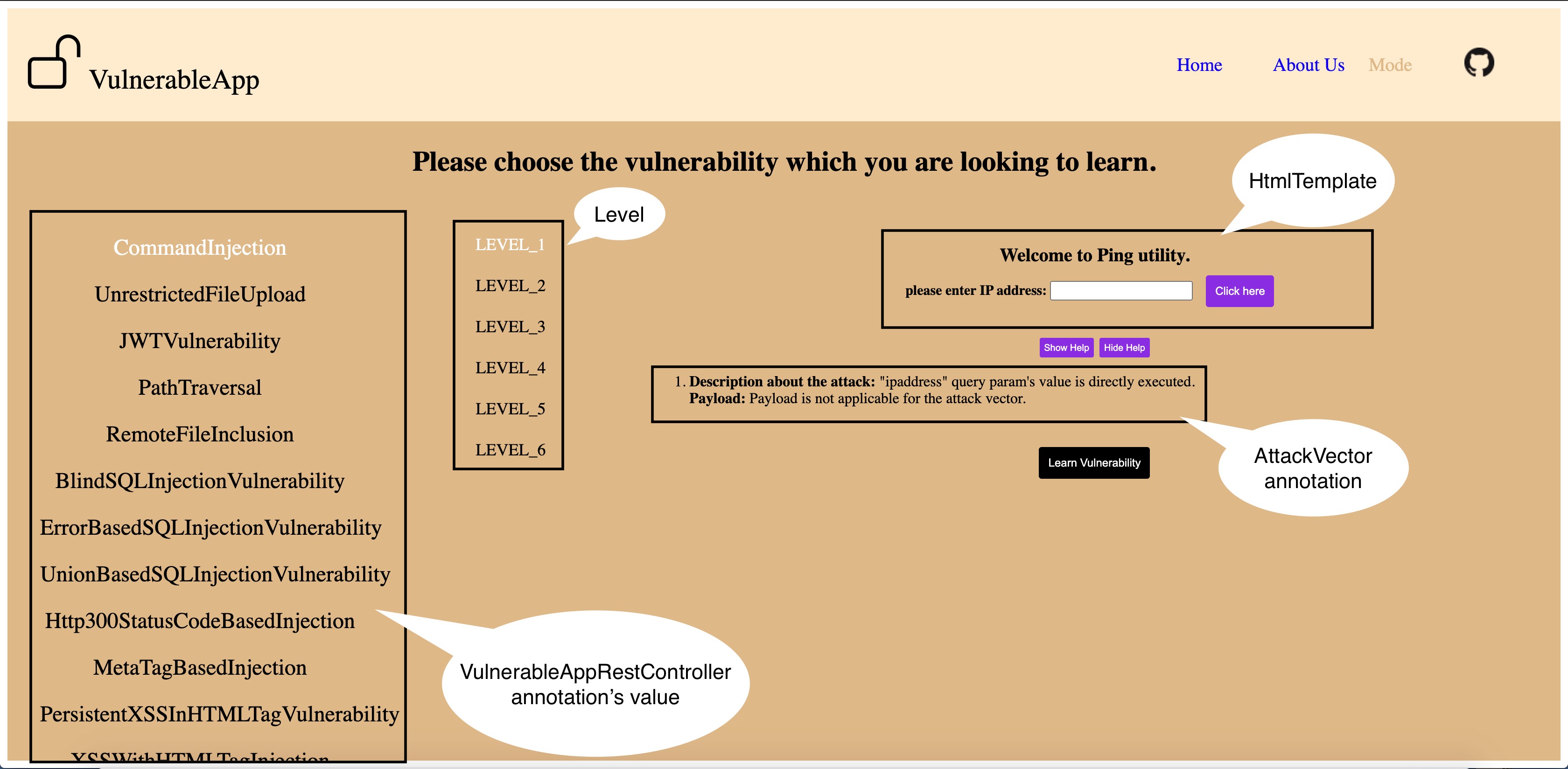Design Documentation
While designing VulnerableApp, major emphasis was given on Ease of adding Vulnerabilities such that developers of Vulnerability Scanners need to put minimal effort for adding new Vulnerabilities for testing their payload/attack vectors.
Technologies used
- Java8
- Spring Boot
- ReactJS
- Vanilla Javascript
Design:
UserInterface for VulnerableApp is driven from backend endpoint “/VulnerabilityDefinitions” which provides entire information about all the Vulnerabilities present in the VulnerableApp. This information is dynamic and is generated from the annotations present over the java class.
Annotations:
There are 3 annotations which are driving the entire VulnerableApp, specifically UserInterface and Vulnerability definitions for Scanners.
- VulnerableAppRestController
- VulnerableAppRequestMapping
- AttackVector
Description:
VulnerableAppRestController: This annotation is annotated with the Spring’s RestController annotation and hences exposes the Vulnerability as Rest Endpoint. Along with exposing the vulnerability as endpoint this annotation is also used to generate the description of the Vulnerability which is shown in the User interface for learning about the vunerability.
For creating a new Vulnerability developers need to add this annotation to there class and a Rest endpoint will get exposed automatically.
VulnerableAppRequestMapping: This annotation is annotated with Spring’s RequestMapping annotation and is used to add the Levels under the Vulnerability which we have specified using the VulnerableAppRestController annotation.
Along with adding Levels to vulnerabilities, there are many parameters in this annotation. lets talk about some of them:
- variant: Each level in VulnerableApp is either Secure or Unsecure, this is specifically done in order to completly test Scanners for false positives or false negatives. This parameter is also used in user interface to indicate to the user if the specific level is exploitable or not.
- htmlTemplate: As UserInterface is driven from annotations so other things in UI like Name of Vulnerabilities, Levels etc are generically populated in the User Interface and the template name mentioned here is used to generate that specific portion of the UI. Template name is appended with .js, .css and .html to find the respective javascript/styling and html for the level.
All the other parameters in the annotations are used for generating information for scanners, specifically /scanner endpoint.
AttackVector:
This annotation is mainly used to help users to exploit the vulnerability. This annotation is used to help students/security enthusiasts about various payloads/ways to expose the vulnerability.
VulnerableApp Legacy User Interface
VulnerableApp’s UI framework is divided into 3 parts:
The VulnerableApp’s screen is divided into 4 parts where 3 parts are generated using above mentioned files and 1 part is generated using htmlTemplate mentioned above.
For more detailed information please look at below labeled images: 

Html Template:
The html template section is generated using htmlTemplate parameter of the annotation and VulnerableApp’s user interface looks for the html/js/css files to generate the User Interface for the selected level in the selected Vulnerability. VulnerableApp’s User Interface will always look for the htmlTemplate under src/main/resources/static/templates/<Vulnerability Name>. Vulnerability Name is same as the value of VulnerableAppRestController annotation’s value parameter.
VulnerableApp’s user interface exposes some of the functionality Out-Of-The-Box like generic utility for doing Ajax Calls, generic css for button animation/look and feel etc.
ReactJS based User Interface
This user interface is provided by one of SasanLabs projects called VulnerableApp-facade. VulnerableApp exposes an endpoint /VulnerabilityDefinitions which holds the information about the Vulnerabilities along with the static resources, which will be leveraged by VulnerableApp-facade to build the User Interface. The information used by VulnerableApp-facade is very similar to the legacy user interface and is derived from the same 3 annotations mentioned above.